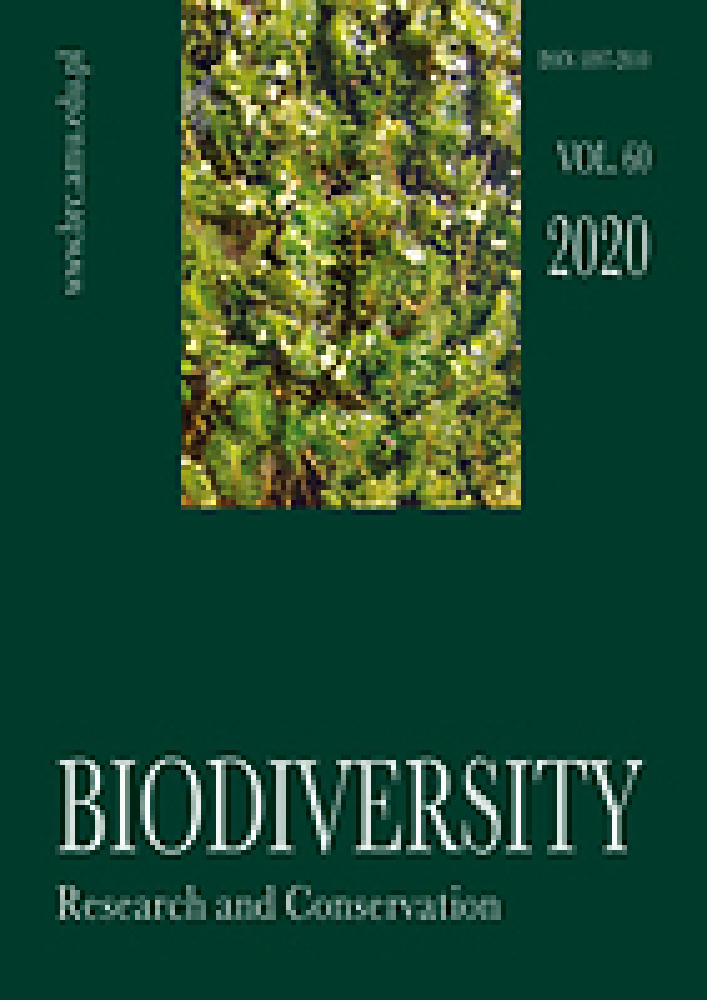Abstract
Groenlandia densa (L.) Fourr. is a native species in Poland of evergreen hydromacrophyte occurring in water-sources or groundwater-fed watercourses. It is a critically endangered taxon which requires active protection. To increase the chance of preserving G. densa population in Western Pomerania, this plant was introduced to the Grabowa and Radew river systems in the Natura 2000 areas PLH 320022 “Radew, Chociela and Chotla Valley” and PLH 320003 “Grabowa Valley”, on a total of 33 sites. In the Radew and its tributaries (Chociel, Zgniła Struga), 6 out of 20 sites were maintained, where reintroduction was successful, while in the Grabowa and its tributaries (Błotnica, Biegała), only 3 out of 13 reintroduction sites survived, and reintroduction in the remaining ones did not bring expected results. Favorable conditions for G. densa were found in initial stages of Beruletum submersae Roll 1938 plant community.
References
Akhani H. 2014. Groenlandia densa. The IUCN Red List of Threatened Species 2014: e.T164174A42321506. http://dx.doi.org/10.2305/IUCN.UK.2014-1.RLTS.T164174A42321506.en
Barrat-Segretain M. H., Bornette G. & Hering-Vilas -Bôas A. 1998. Comparative abilities of vegetative regeneration among aquatic plants growing in disturbed habitats. Aquatic botany 60(3): 201-211. https://doi.org/10.1016/S0304-3770(97)00091-0
Barrat-Segretain M. H. 1996. Strategies of reproduction, dispersion, and competition in river plants: A Review. Vegetatio 123(1): 13-37. https://www.jstor.org/stable/20048649
Bartnik A. & Moniewski P. 2016. Changes in water quality of a small urban river triggered by deep drainage of a construction site. Journal of Water and Land Development.31:11-22. https://doi.org/10.1515/jwld-2016-0032 https://doi.org/10.1515/jwld-2016-0016
Berantowicz S. & Wolny P. 1969. Botanika rybacka. 420 pp. PWRiL, Warszawa.
Bonisławska M., Nędzarek A., Rybczyk A., Czerniejewski P. & Żuk B. 2017. Zmiany warunków abiotycznych małej rzeki z uwzględnieniem wpływu wód poprodukcyjnych z hodowli ryb. Woda-Środowisko-Obszary Wiejskie 17, 4(60): 5-23.
Bornette G. & Puijalon S. 2011. Response of aquatic plants to abiotic factors: a review. Aquat Sci 73: 1-14. https://doi.org/10.1007/s00027-010-0162-7
Duygu Y. & Kadiriye U.P. 2011. Modelling the influence of salinity and water deficiency on the growth and biomass of Groenlandia densa (Potamogetonaceae). F. Environ. Bulletin. 20(7).
Elger A., Bornette G., Barrat-Segretain M. & Amoros C. 2004. Disturbances as a structuring factor of plant palatability in aquatic communities. Ecology 85(2): 304-311. www.jstor.org/stable/3450196
Greulich S. & Bornette G. 1999. Competitive abilities and related strategies in four aquatic plant species from an intermediately disturbed habitat. Freshwater Biology 41(3): 493-506. https://doi.org/10.1046/j.1365-2427.1999.00395.x
Greulich S. & Bornette G. 2003. Being evergreen in an aquatic habitat with attenuated seasonal contrast – a major competitive advantage? Plant Ecology 167(1): 9-18. https://doi.org/10.1023/A:1023923418919
Henry C., Amoros C. & Bornette G. 1996. Species traits and recolonization processes after flood disturbances in riverine macrophytes. Vegetatio 122(1): 13-27. www. jstor.org/stable/20048622
Kaźmierczakowa R., Zarzycki K. & Mirek Z. (eds) 2014. Polish Red Data Book of Plants. Pteridophytes and flowering plants. III edition, 895 pp. Institute of Nature Conservation, Polish Academy of Sciences, Kraków.
Kaźmierczakowa R., Bloch-Orłowska J., Celka Z., Cwener A., Dajdok Z., Michalska-Hejduk D., Pawlikowski P., Szczęśniak E. & Ziarnek K. 2016. Polish red list of pteridophytes and flowering plants. 44 pp. Instytut Ochrony Przyrody Polskiej Akademii Nauk, Kraków.
Lepš J. & Šmilauer P. 2003. Multivariate analysis of ecological data using CANOCO. Cambridge University Press. https://doi.org/10.1017/CBO9780511615146
Matuszkiewicz W. 2013. Przewodnik do oznaczania zbiorowisk roślinnych Polski. In: J. B. Faliński (ed.). Vademecum Geobotanicum 3, 537 pp. III ed. Wyd. Nauk. PWN, Warszawa.
Mirek Z., Piękoś-Mirkowa H., Zając A. & Zając M. 2002. Flowering plants and pteridophytes of Poland. A checklist. In: Z. Mirek (ed.). Biodiversity of Poland, 1, 442 pp. W. Szafer Institute of Botany, Polish Academy of Sciences, Kraków.
Pawlaczyk P. 2017. Ecological problems of river conservation in Polish Natura 2000 sites. Przegląd Przyrodniczy 28(4): 16-50.
Puchalski W. 2004. Nizinne i podgórskie rzeki ze zbiorowiskami włosieniczników. In: J. Herbich (ed.) Natura 2000 manual for the protection of habitats and species – methodological manual. Vol. 2. Fresh waters and peat bogs, pp. 96-108. Ministry of the Environment, Warszawa.
Puchalski W., Cieślak E., Nowak J. & Żukowski W. 2016. Czy introdukcja Groenlandia densa (Potamogetonaceae) w Polsce ma szanse powodzenia? Fragm. Flor. Geobot. Polonica 23(2): 289-304.
Puijalon S., Piola F. & Bornette G. 2008. Abiotic stresses increase plant regeneration ability. Evol Ecol (2008) 22: 493-506. https://doi.org/10.1007/s10682-007-9177-5
Ratyńska H., Wojterska M. & Brzeg A. 2010. Multimedialna encyklopedia zbiorowisk roślinnych Polski. Uniwersytet Kazimierza Wielkiego, Bydgoszcz, wyd. multimedialne CD.
Regulation of the Polish Minister of Environment of October 9, 2014, on the protection for species of plants (Official Journal of October 16, 2014, item 1409)
Rutkowski L. 2004. Klucz do oznaczania roślin naczyniowych Polski niżowej. II edition, 814 pp. Wyd. Nauk. PWN, Warszawa.
Schütz W. 1995. Vegetation of running waters in Southwestern Germany – pristine conditions and human impact. Acta Botanica Gallica 142(6): 571-584. https://doi.org/10.1080/12538078.1995.10515281
Szoszkiewicz K. & Gebler D. 2012. Nizinne i podgórskie rzeki ze zbiorowiskami włosieniczników. In: W. Mróz (ed.). Monitoring of natural habitats. Methodical guide. Part 2, GIOŚ, pp. 204-217. Warszawa.
Szpikowski J., Piotrowicz R. & Szpikowska G. 2016. Raport z zadania “Monitoring hydrodynamiki fluwialnej dolin rzecznych oraz warunków siedliskowych dla rozwoju roślinności wodnej ze związku Ranunculion fluitantis z jej aktualnym stanem”. Manuskrypt dla RDOŚ w Szczecinie, w tamach projektu LIFE13 NAT/ PL/0009 LIFEDrawa PL: 329. http://drawalifeplus.rdos.szczecin.pl/index.php/pl/raporty-z-realizacji/
Tarkowska-Kukuryk M. & Mieczan T. 2017. Submerged macrophytes as bioindicators of environmental conditions in shallow lakes in eastern Poland. Ann. Limnol. – Int. J. Lim. 53: 27-34. https://doi.org/10.1051/limn/2016031
Ziarnek K. 2017. Potrzeba restytucji wybranych gatunków roślin zagrożonych wyginięciem w celu wzmocnienia ich dziko występujących populacji wraz z analizą zasobów ogrodów botanicznych pod kątem posiadania tych gatunków. GDOŚ w Warszawie, Lonicera, Szczecin.
Żukowski W. 2014. CR Groenlandia densa (L.) Fourr., Rdestniczka gęsta (rdestnica gęsta, grenlandia gęsta). In: R. Kaźmierczakowa, K. Zarzycki & Mirek Z. (eds). Polish Red Data Book of Plants: Pteridophytes and Flowering Plants, pp. 574-575. Institute of Nature Conservation, Polish Academy of Sciences, Kraków.
License
Copyright (c) 2020 Mariola Wróbel, Artur Furdyna, Tymoteusz Miller

This work is licensed under a Creative Commons Attribution-NonCommercial-NoDerivatives 4.0 International License.





